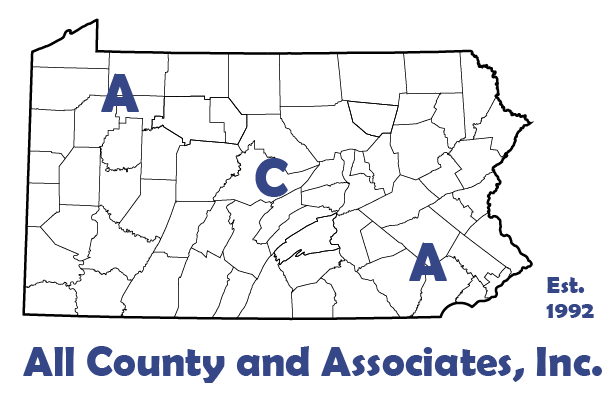
We are closing in on the end of our journey. This week marks the sixth post in our seven-part series on land planning in Pennsylvania. First, we learned about the municipal code. Next, we looked at planning commissions and the elements of zoning. Now, let’s look at the most common process of land planning, subdivision and land development.
Introduction
In Pennsylvania, 90% of municipalities have some form of a Subdivision and Land Development Ordinance (SALDO). To start with, subdivision is the process of creating new property lines. Whereas, land development sets the requirements for buildings and improvements. The codification of these regulations is the SALDO.
The goal of the SALDO is to set design standards. Furthermore, these standards are consistent throughout the municipality. Their goal is to protect the municipality from future costs. These costs relate to unplanned and poorly designed development. It also controls costs by requiring developers to pay for improvements to infrastructure. Finally, it prevents excess noise, light pollution, stormwater damage, etc.
Series Index:
- Municipal Planning Code and Local Land Use Controls
- Planning Commissions
- Zoning and Zoning Officer
- Zoning Hearing Board
- Special Exceptions, Conditional Uses and Variances
- Subdivision and Land Development
- Agricultural Planning
Ordinance
The MPC states that the SALDO must cover many different elements. It begins with ensuring arrangement of lots. Next, comes setting standards for the size and grade of accessways (driveways and roads). Other key elements include sidewalks, landscaping and stormwater management. Additionally, the ordinance establishes requirements for easements or rights-of-ways. These easements provide access for future maintenance.
Beyond these design elements, the ordinance establishes requirements for plan preparation. These requirements correspond with procedures for the submission and review of applications. Finally, the ordinance contains requirements for the administration of the ordinance. These administrative items include fees, reviewer, coordination with other agencies and violation procedures.
One unique element of subdivision and land development is sewage planning. In Pennsylvania, the Sewage Facilities Act, Act 537, regulates sewage planning. Act 537 states that a subdivision or land development must prove it can provide safe and adequate sewer facilities. Therefore, some projects must submit a planning module. This module revises the municipality’s Act 537 plan. Since 1971, a sewage planning module approval has been a required part of a subdivision. Finally, PA DEP requires an adequate primary and secondary treatment area be provided for new subdivisions relying on an on-site sewage (septic) system.
Processing and Administration
As noted, the SALDO includes requirements for the administration. This includes criteria for processing applications. Applications are acceptable at the time of administrative completeness. This occurs at the next meeting of the reviewing body after the submission. Although, this acceptance can only occur upon a complete submission. Hence, a complete submission must include all the items prescribed in the ordinance. Typically, a complete submission includes an application, plans and reports/documents.
Also, the MPC establishes processing timeframes. This starts with a 90-day time frame from first meeting to decision. Because of this, some applications need an extension request. In most cases, the first response is before the next meeting after the initial acceptance. This is a written response to the applicant, which contains the reason for denial (or approval). If denied, it includes any deficiencies. As a result, the consultant addresses the comments and resubmits. This coupled with other agency reviews take longer than 90-days on larger projects. After approval, or final denial, the governing body has 15 days to send their written decision.
The MPC includes stipulations to protect the applicant as well. The first is that any update to the ordinances during the review process will not impact the project. Next, new conditions cannot be added between preliminary and final approval. Finally, within five years of the application, ordinances changes cannot change or revoke a substantially complete project’s approval.
Planning Knowledge
In the end, it is important to remember that land planning is a very complex process with many nuances. During these posts, we have tried to convey the basic information about land planning in Pennsylvania. Before we end this series, we will have one more post on a very unique industry. Agricultural is Pennsylvania’s largest industry and thus has some special requirements and conditions. We will explore these elements in our last post of the land planning series.
Who is ACA?
Started in 1992 and located in Chester County, PA ACA has grown to become a full-service civil engineering firm. Today, we merge professional services with practical knowledge for residential and commercial projects. No matter the scale, from installing a fence, to building a structure or developing land, you need permits. Because the approval process includes many permits and agencies, it can be a headache. Working with ACA’s full-service team saves you time, money, and headaches. Every step of the way, we are here to support you and educate you about the process. Here are some of the basic services we provide:
Construction Management | Civil Engineering | Environmental Permitting | Septic System Testing and Design | Land Surveying | Wetland Delineations and Mitigation
Please feel free to browse our website or if working on a project or need help, contact us at (610) 469-3830.


